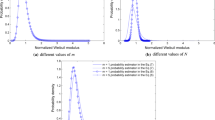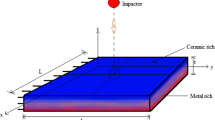Abstract
The purpose of this study was to develop a product design model for estimating the impact toughness of low-alloy steel plates. The rejection probability in a Charpy-V test (CVT) is predicted with process variables and chemical composition. The proposed method is suitable for the whole production line of a steel plate mill, including all grades of steel in production. The quantile regression model was compared to the joint model of mean and dispersion and the constant variance model. The quantile regression model proved out to be the most effective method for modelling a highly complicated property at this extent.
Next, the developed model will be implemented into a graphical simulation tool that is in daily use in the product planning department and already contains some other mechanical property models. The model will guide designers in predicting the related risk of rejection and in producing desired properties in the product at lower cost.
Access this chapter
Tax calculation will be finalised at checkout
Purchases are for personal use only
Preview
Unable to display preview. Download preview PDF.
Similar content being viewed by others
References
Tóth, L., Rossmanith, H.P., Siewert, T.: Historical background and development of the charpy test. In: François, D., Pineau, A. (eds.) From Charpy to Present Impact Testing. Elsevier Science Ltd., UK (2002)
Wallin, K., Nevasmaa, P., Planman, T., Valo, M.: Evaluation of the charpy-v test from a quality control test to a materials evaluation tool for structural integrity assessment. In: François, D., Pineau, A. (eds.) From Charpy to Present Impact Testing. Elsevier Science Ltd., UK (2002)
Lindroos, Sulonen, Veistinen: Uudistettu Miekk-ojan metallioppi. Otava, Finland (1986) (In Finnish)
Cawley, G., Janacek, G., Haylock, M., Dorling, S.: Predictive uncertainty in environmental modelling. Neural Networks 20, 537–549 (2007)
Haušild, P.: The influence of ductile tearing on fracture energy in the ductile-to-brittle transition temperature range. Materials Science and Engineering A335, 164–174 (2002)
Todinov, M.: Uncertainty and risk associated with the Charpy impact energy of multi-run welds. Nuclear Engineering and Design 231, 27–38 (2004)
Bhadeshia, H.: Neural networks in materials science. ISIJ International 39(10), 966–979 (1999)
Malinov, S., Sha, W., McKeown, J.: Modelling the correlation between processing parameters and properties in titaniumalloys using artificial neural network. ComputationalMaterials Science 21, 375–394 (2001)
Golodnikov, A., Macheret, Y., Trindade, A., Uryasev, S., Zrazhevsky, G.: Statistical modeling of composition and processing parameters for alloy development. Modelling and Simulation in Materials Science and Engineering 13(4), 633–644 (2005)
Koenker, R.: Quantile Regression. Cambridge University Press, USA (2005)
Yu, K., Lu, Z., Stander, J.: Quantile regression: Applications and current research areas. The Statistician 52(3), 331–350 (2003)
Engel, J.: Modelling variation in industrial experiments. Applied Statistics 41(3), 579–593 (1992)
Carroll, R., Ruppert, D.: Transformation and Weighting in Regression. Chapman and Hall, USA (1988)
Smyth, G., Huele, A., Verbyla, A.: Exact and approximate REML for heteroscedastic regression. Statistical Modelling 1(3), 161–175 (2001)
Juutilainen, I.: Modelling of Conditional Variance and Uncertainty Using Industrial Process Data. PhD thesis, University of Oulu, Finland (2006)
Juutilainen, I., Röning, J.: Modelling the probability of rejection in a qualification test based on process data. In: Proc. 16th Symposium of IASC (COMPSTAT 2004), Prague, Czech Republic, August 23-27, pp. 1271–1278 (2004)
Koenker, R., Hallock, K.: Quantile regression. Journal of Economic Perspectives 15(4), 143–156 (2001)
Bishop, C.: Neural Networks for Pattern Recognition. Oxford University Press, Inc., USA (1995)
Svozil, D., Kvasnička, V., Pospichal, J.: Introduction to multi-layer feed-forward neural networks. Chemometrics and Intelligent Laboratory Systems 39, 43–62 (1997)
Harvey, A.: Regression models with multiplicative heteroscedasticity. Econometrica 44(3), 461–465 (1976)
Saerens, M.: Building cost functions minimizing to some summary statistics. IEEE Transactions on Neural Networks 11(6), 1263–1271 (2000)
Dorling, S., Foxall, R., Mandic, D., Cawley, G.: Maximum likelihood cost functions for neural network models of air quality data. Atmospheric Environment 37, 3435–3443 (2003)
Laurinen, P., Tuovinen, L., Röning, J.: Smart archive: A component-based data mining application framework. In: Proc. 5th International Conference on Intelligent Systems Design and Applications, Wroclaw, Poland, September 8-10, pp. 20–26 (2005)
Author information
Authors and Affiliations
Editor information
Editors and Affiliations
Rights and permissions
Copyright information
© 2010 Springer-Verlag Berlin Heidelberg
About this paper
Cite this paper
Tamminen, S., Juutilainen, I., Röning, J. (2010). Quantile Regression Model for Impact Toughness Estimation. In: Perner, P. (eds) Advances in Data Mining. Applications and Theoretical Aspects. ICDM 2010. Lecture Notes in Computer Science(), vol 6171. Springer, Berlin, Heidelberg. https://doi.org/10.1007/978-3-642-14400-4_21
Download citation
DOI: https://doi.org/10.1007/978-3-642-14400-4_21
Publisher Name: Springer, Berlin, Heidelberg
Print ISBN: 978-3-642-14399-1
Online ISBN: 978-3-642-14400-4
eBook Packages: Computer ScienceComputer Science (R0)




